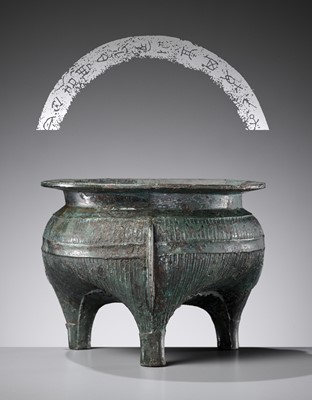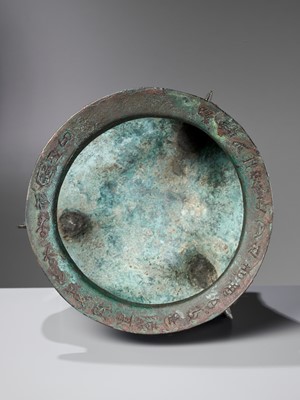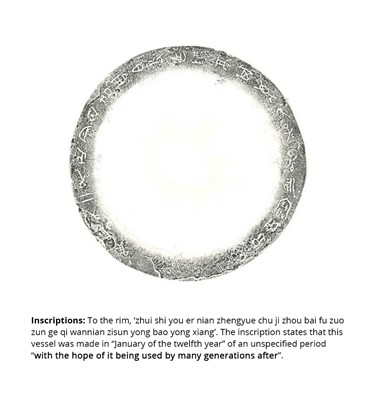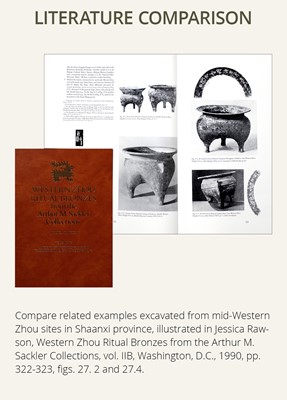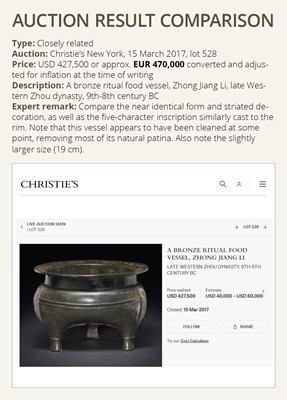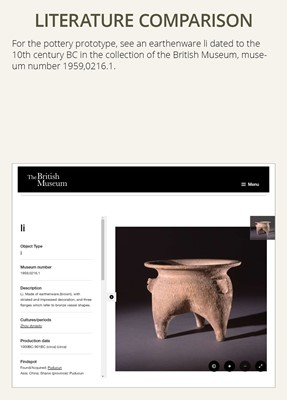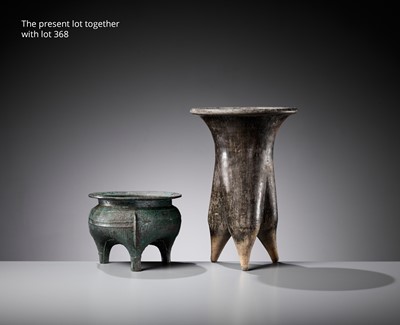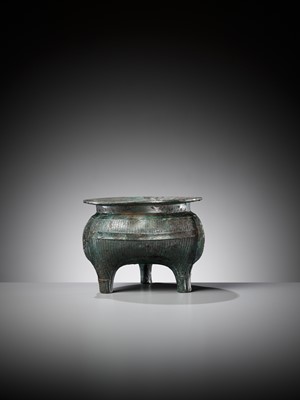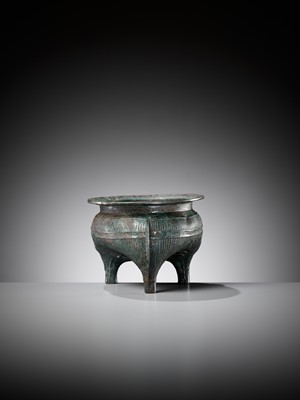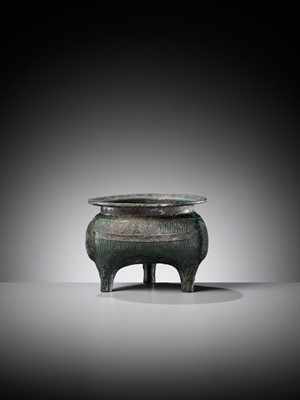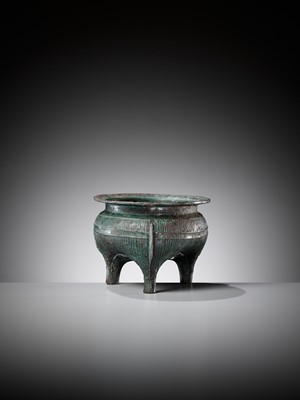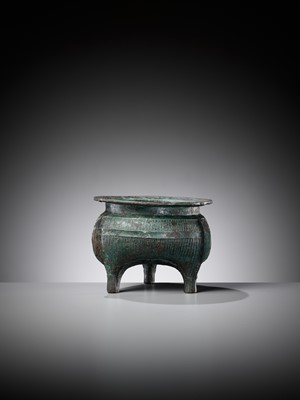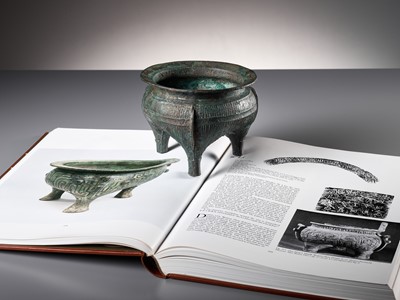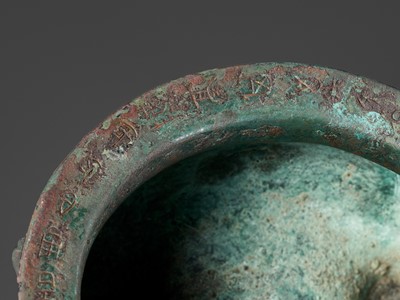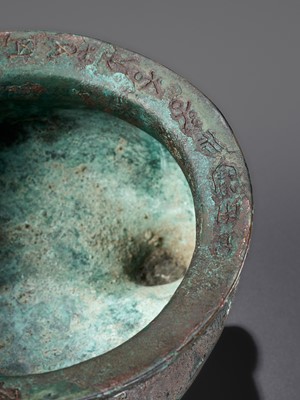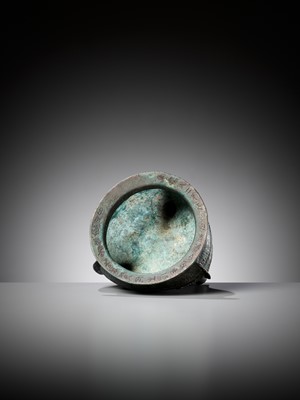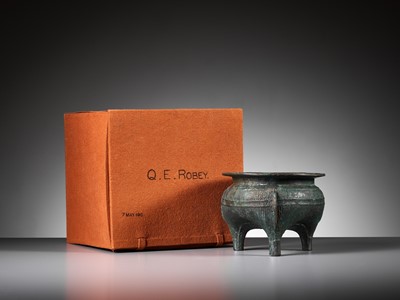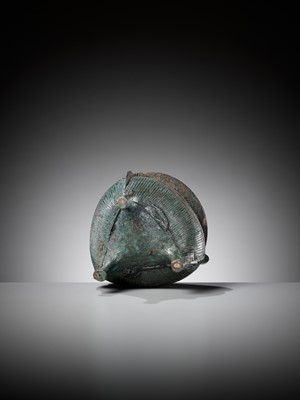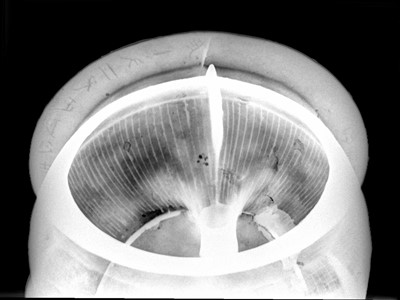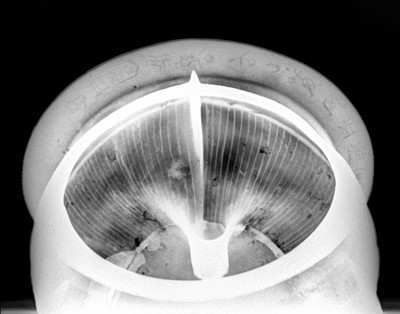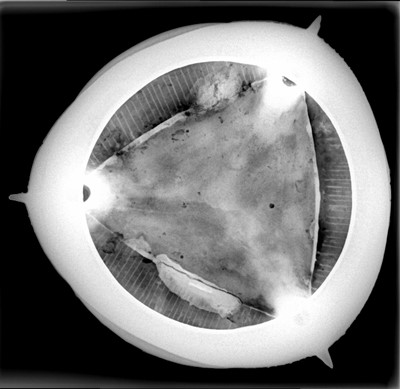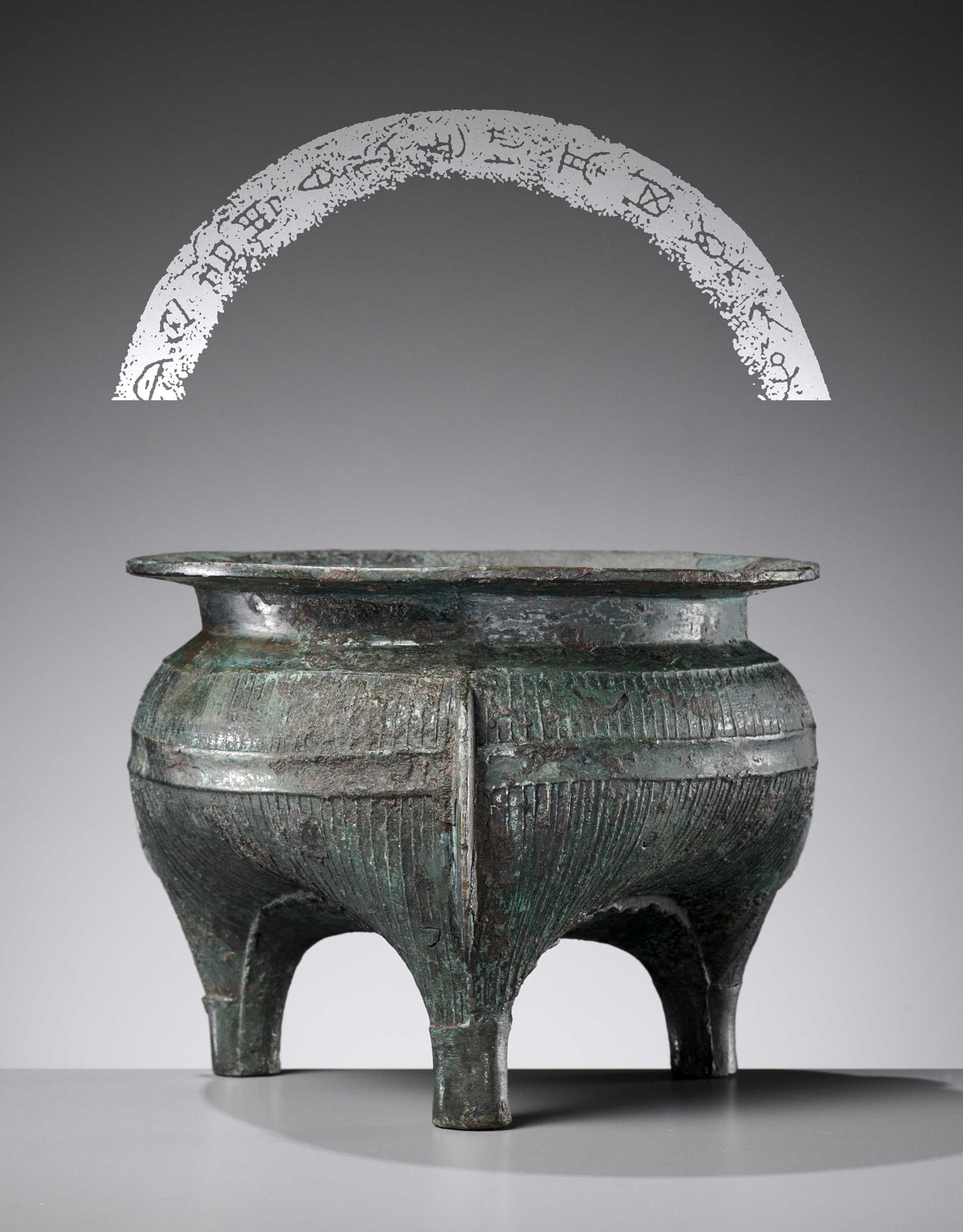29th Sep, 2022 13:00
DAY 1 - TWO-DAY AUCTION - Fine Chinese Art / 中國藝術集珍 / Buddhism & Hinduism
137
AN IMPORTANT AND RARE BRONZE RITUAL FOOD VESSEL, LI, WITH 24-CHARACTER INSCRIPTION, LATE WESTERN ZHOU DYNASTY
西周晚期青銅禮器鬲
Sold for €26,000
including Buyer's Premium
Inscriptions: To the rim, ‘zhui shi you er nian zhengyue chu ji zhou bai fu zuo zun ge qi wannian zisun yong bao yong xiang’. The inscription states that this vessel was made in “January of the twelfth year” of an unspecified period “with the hope of it being used by many generations after”.
Opinion: This spectacular li vessel compares more than favorably to the Zhong Jiang Li previously in the Fujita Museum and sold at Christie’s in 2017. Not only do these two vessels share more or less the same form and decoration, they are also both inscribed at the top of the rim – although the inscription on the present vessel is substantially longer. There are, however, some key differences between the two that should be of great interest to the astute collector. For one, the Zhong Jiang Li must at some point have been cleaned, as it lacks the beautiful patina of our li. However, its provenance is well-documented, going back to the 19th century, which goes some way to explain the high price it reached at auction. In terms of quality though, the present li is in no way inferior to the Zhong Jiang li, and very much deserves the same attention.
China, 9th-8th century BC. The tri-lobed body is supported on three hoof-shaped feet, and cast on the sides with raised vertical lines divided by plain horizontal bands and narrow flanges. The everted rim is crisply cast with a 24-character inscription. The vessel has a superb, naturally grown patina with extensive malachite encrustation.
Provenance: From an old English private collection, acquired in the 1950s and thence by descent within the same family. The fitted box is inscribed with the collector's name "Q.E. Robey" and dated "7. May 195".
Condition: Remarkably well preserved and substantially better than expected. Some revision work dating to the period of creation and subsequent usage, such as small patches and fills, must not be mistaken for modern restorations. A minor dent to the shoulder. Old wear and weathering, soil encrustations, minor areas of corrosion, some smaller nicks here and there. The inscriptions are crisp and well-defined. Superb, naturally grown patina.
X-Ray images: Images 19 and 20 show the inscription and confirm its originality. Image 21 reveals the small patches mentioned in the condition report. (more images available upon request)
Weight: 962.7 g
Dimensions: Width 16.2 cm (measured rim to flange), diameter 15.4 cm (measured at the mouth rim)
Fitted box, dating from the early to mid-20th century. (2)
Li with striated decoration were inspired by pottery prototypes and were popular during the middle to late Western Zhou dynasty. A set of five similar li vessels with Wei Bo inscriptions was found in a hoard in Zhuangbai village, Fufeng county, Shaanxi province, and illustrated by Wu Zhenfeng in Shangzhou qingtongqi mingwen ji tuxiang jicheng (Complete Collection of Inscriptions and Images of the Shang and Zhou Bronzes), vol. 6, Shanghai, 2012, pp. 85-89, nos. 2702-2706. The Wei Bo li have more slender legs and taller proportions than the present li and can be dated by inscription to the latter part of the middle Western Zhou dynasty. A group of late Western Zhou li vessels with Zhong Ji inscriptions are very similar to the present li. See ibid., pp. 127-133, nos. 2746-2752.
Literature comparison:
Compare related examples excavated from mid-Western Zhou sites in Shaanxi province, illustrated in Jessica Rawson, Western Zhou Ritual Bronzes from the Arthur M. Sackler Collections, vol. IIB, Washington, D.C., 1990, pp. 322-323, figs. 27. 2 and 27.4. Compare also a li of similar size and design, from the Arthur M. Sackler Collections, illustrated ibid., pp. 330-331, no. 27.
For the pottery prototype, see an earthenware li dated to the 10th century BC in the collection of the British Museum, museum number 1959,0216.1.
Auction result comparison:
Type: Closely related
Auction: Christie’s New York, 15 March 2017, lot 528
Price: USD 427,500 or approx. EUR 470,000 converted and adjusted for inflation at the time of writing
Description: A bronze ritual food vessel, Zhong Jiang Li, late Western Zhou dynasty, 9th-8th century BC
Expert remark: Compare the near identical form and striated decoration, as well as the five-character inscription similarly cast to the rim. Note that this vessel appears to have been cleaned at some point, removing most of its natural patina. Also note the slightly larger size (19 cm).
西周晚期青銅禮器鬲
中國,公元前九世紀至八世紀。青銅食器。敞口,束頸,分襠,鼓腹,下置三短蹄狀足。腹飾條紋,扉棱。此器口沿變寬,便於手端,代替立耳,簡潔明快。外翻的邊緣清晰地鑄有 24 個字銘文。極好的自然生長的包漿,大量結殼。
款識:隹十又二年正月初吉周白父作尊鬲,其萬年子孫永寶用享
專家注釋: 這件極爲難得的禮器與之前在藤田博物館中並於 2017 年在佳士得拍賣的仲姜鬲相比毫不遜色。這兩件器皿不僅形式和紋飾大致相同,而且都刻在頂部邊緣——雖然此禮器上的銘文要長得多。然而,精明的收藏家應該對兩者之間的一些關鍵區別感興趣。一方面,仲姜鬲一定在某個時候被清洗過,因為它缺乏天然的包漿美麗光澤。然而,它的出處有據可查,可以追溯到 19 世紀,這在一定程度上解釋了它在拍賣中達到的高價的原因。不過從質量上來說,現在的鬲絲毫不遜色於仲姜鬲,非常值得關注。
來源:英國私人收藏,購於上世紀五十年代,自此保存在同一家族至今。相配的盒子上寫著藏家的名字"Q.E. Robey"以及日期 "7. May 195"。
品相:品相極好,比預期的要好得多。 有小補丁和填充,不是現代修復。肩部有輕微凹痕。磨損和風化,土壤結殼,輕微的腐蝕區域,很多小刻痕。銘文清晰明了。自然生長的包漿。
重量:962.7 克
尺寸:寬 16.2 厘米(邊沿到扉棱), 直徑15.4 厘米(唇沿)
相配的盒子,約為二十世紀初期至中期。
文獻比較:
比較一件相似的例子,於陝西出土的西周中期鬲,見Jessica Rawson,《Western Zhou Ritual Bronzes from the Arthur M. Sackler Collections》,卷IIB,華盛頓D.C.,1990年,頁322-323,圖27. 2和27.4。比較同本書的另一件相似尺寸和形制的鬲,頁330-331,編號27。
關於陶器的原型,見大英博物館收藏的西元前10世紀的陶器鬲,博物館編號1959,0216.1。
拍賣結果比較:
形制:非常相近
拍賣:紐約佳士得,2017年3月15日,lot 528
價格:USD 427,500(相當於今日EUR 470,000)
描述:西元前九至八世紀西周晚期青銅禮器鬲
專家評論:比較幾乎相似的形式和條紋裝飾,而且外翻的邊緣也同樣鑄有五個字的銘文。請注意,此器似乎在某個時候被清洗過,去掉了大部分的自然包漿,且尺寸稍大(19 厘米)。
Inscriptions: To the rim, ‘zhui shi you er nian zhengyue chu ji zhou bai fu zuo zun ge qi wannian zisun yong bao yong xiang’. The inscription states that this vessel was made in “January of the twelfth year” of an unspecified period “with the hope of it being used by many generations after”.
Opinion: This spectacular li vessel compares more than favorably to the Zhong Jiang Li previously in the Fujita Museum and sold at Christie’s in 2017. Not only do these two vessels share more or less the same form and decoration, they are also both inscribed at the top of the rim – although the inscription on the present vessel is substantially longer. There are, however, some key differences between the two that should be of great interest to the astute collector. For one, the Zhong Jiang Li must at some point have been cleaned, as it lacks the beautiful patina of our li. However, its provenance is well-documented, going back to the 19th century, which goes some way to explain the high price it reached at auction. In terms of quality though, the present li is in no way inferior to the Zhong Jiang li, and very much deserves the same attention.
China, 9th-8th century BC. The tri-lobed body is supported on three hoof-shaped feet, and cast on the sides with raised vertical lines divided by plain horizontal bands and narrow flanges. The everted rim is crisply cast with a 24-character inscription. The vessel has a superb, naturally grown patina with extensive malachite encrustation.
Provenance: From an old English private collection, acquired in the 1950s and thence by descent within the same family. The fitted box is inscribed with the collector's name "Q.E. Robey" and dated "7. May 195".
Condition: Remarkably well preserved and substantially better than expected. Some revision work dating to the period of creation and subsequent usage, such as small patches and fills, must not be mistaken for modern restorations. A minor dent to the shoulder. Old wear and weathering, soil encrustations, minor areas of corrosion, some smaller nicks here and there. The inscriptions are crisp and well-defined. Superb, naturally grown patina.
X-Ray images: Images 19 and 20 show the inscription and confirm its originality. Image 21 reveals the small patches mentioned in the condition report. (more images available upon request)
Weight: 962.7 g
Dimensions: Width 16.2 cm (measured rim to flange), diameter 15.4 cm (measured at the mouth rim)
Fitted box, dating from the early to mid-20th century. (2)
Li with striated decoration were inspired by pottery prototypes and were popular during the middle to late Western Zhou dynasty. A set of five similar li vessels with Wei Bo inscriptions was found in a hoard in Zhuangbai village, Fufeng county, Shaanxi province, and illustrated by Wu Zhenfeng in Shangzhou qingtongqi mingwen ji tuxiang jicheng (Complete Collection of Inscriptions and Images of the Shang and Zhou Bronzes), vol. 6, Shanghai, 2012, pp. 85-89, nos. 2702-2706. The Wei Bo li have more slender legs and taller proportions than the present li and can be dated by inscription to the latter part of the middle Western Zhou dynasty. A group of late Western Zhou li vessels with Zhong Ji inscriptions are very similar to the present li. See ibid., pp. 127-133, nos. 2746-2752.
Literature comparison:
Compare related examples excavated from mid-Western Zhou sites in Shaanxi province, illustrated in Jessica Rawson, Western Zhou Ritual Bronzes from the Arthur M. Sackler Collections, vol. IIB, Washington, D.C., 1990, pp. 322-323, figs. 27. 2 and 27.4. Compare also a li of similar size and design, from the Arthur M. Sackler Collections, illustrated ibid., pp. 330-331, no. 27.
For the pottery prototype, see an earthenware li dated to the 10th century BC in the collection of the British Museum, museum number 1959,0216.1.
Auction result comparison:
Type: Closely related
Auction: Christie’s New York, 15 March 2017, lot 528
Price: USD 427,500 or approx. EUR 470,000 converted and adjusted for inflation at the time of writing
Description: A bronze ritual food vessel, Zhong Jiang Li, late Western Zhou dynasty, 9th-8th century BC
Expert remark: Compare the near identical form and striated decoration, as well as the five-character inscription similarly cast to the rim. Note that this vessel appears to have been cleaned at some point, removing most of its natural patina. Also note the slightly larger size (19 cm).
西周晚期青銅禮器鬲
中國,公元前九世紀至八世紀。青銅食器。敞口,束頸,分襠,鼓腹,下置三短蹄狀足。腹飾條紋,扉棱。此器口沿變寬,便於手端,代替立耳,簡潔明快。外翻的邊緣清晰地鑄有 24 個字銘文。極好的自然生長的包漿,大量結殼。
款識:隹十又二年正月初吉周白父作尊鬲,其萬年子孫永寶用享
專家注釋: 這件極爲難得的禮器與之前在藤田博物館中並於 2017 年在佳士得拍賣的仲姜鬲相比毫不遜色。這兩件器皿不僅形式和紋飾大致相同,而且都刻在頂部邊緣——雖然此禮器上的銘文要長得多。然而,精明的收藏家應該對兩者之間的一些關鍵區別感興趣。一方面,仲姜鬲一定在某個時候被清洗過,因為它缺乏天然的包漿美麗光澤。然而,它的出處有據可查,可以追溯到 19 世紀,這在一定程度上解釋了它在拍賣中達到的高價的原因。不過從質量上來說,現在的鬲絲毫不遜色於仲姜鬲,非常值得關注。
來源:英國私人收藏,購於上世紀五十年代,自此保存在同一家族至今。相配的盒子上寫著藏家的名字"Q.E. Robey"以及日期 "7. May 195"。
品相:品相極好,比預期的要好得多。 有小補丁和填充,不是現代修復。肩部有輕微凹痕。磨損和風化,土壤結殼,輕微的腐蝕區域,很多小刻痕。銘文清晰明了。自然生長的包漿。
重量:962.7 克
尺寸:寬 16.2 厘米(邊沿到扉棱), 直徑15.4 厘米(唇沿)
相配的盒子,約為二十世紀初期至中期。
文獻比較:
比較一件相似的例子,於陝西出土的西周中期鬲,見Jessica Rawson,《Western Zhou Ritual Bronzes from the Arthur M. Sackler Collections》,卷IIB,華盛頓D.C.,1990年,頁322-323,圖27. 2和27.4。比較同本書的另一件相似尺寸和形制的鬲,頁330-331,編號27。
關於陶器的原型,見大英博物館收藏的西元前10世紀的陶器鬲,博物館編號1959,0216.1。
拍賣結果比較:
形制:非常相近
拍賣:紐約佳士得,2017年3月15日,lot 528
價格:USD 427,500(相當於今日EUR 470,000)
描述:西元前九至八世紀西周晚期青銅禮器鬲
專家評論:比較幾乎相似的形式和條紋裝飾,而且外翻的邊緣也同樣鑄有五個字的銘文。請注意,此器似乎在某個時候被清洗過,去掉了大部分的自然包漿,且尺寸稍大(19 厘米)。
Zacke Live Online Bidding
Our online bidding platform makes it easier than ever to bid in our auctions! When you bid through our website, you can take advantage of our premium buyer's terms without incurring any additional online bidding surcharges.
To bid live online, you'll need to create an online account. Once your account is created and your identity is verified, you can register to bid in an auction up to 12 hours before the auction begins.
Intended Spend and Bid Limits
When you register to bid in an online auction, you will need to share your intended maximum spending budget for the auction. We will then review your intended spend and set a bid limit for you. Once you have pre-registered for a live online auction, you can see your intended spend and bid limit by going to 'Account Settings' and clicking on 'Live Bidding Registrations'.
Your bid limit will be the maximum amount you can bid during the auction. Your bid limit is for the hammer price and is not affected by the buyer’s premium and VAT. For example, if you have a bid limit of €1,000 and place two winning bids for €300 and €200, then you will only be able to bid €500 for the rest of the auction. If you try to place a bid that is higher than €500, you will not be able to do so.
Online Absentee and Telephone Bids
You can now leave absentee and telephone bids on our website!
Absentee Bidding
Once you've created an account and your identity is verified, you can leave your absentee bid directly on the lot page. We will contact you when your bids have been confirmed.
Telephone Bidding
Once you've created an account and your identity is verified, you can leave telephone bids online. We will contact you when your bids have been confirmed.
Classic Absentee and Telephone Bidding Form
You can still submit absentee and telephone bids by email or fax if you prefer. Simply fill out the Absentee Bidding/Telephone bidding form and return it to us by email at office@zacke.at or by fax at +43 (1) 532 04 52 20. You can download the PDF from our Upcoming Auctions page.
How-To Guides
How to Create Your Personal Zacke Account
How to Register to Bid on Zacke Live
How to Leave Absentee Bids Online
How to Leave Telephone Bids Online
中文版本的操作指南
创建新账号
注册Zacke Live在线直播竞拍(免平台费)
缺席投标和电话投标
Third-Party Bidding
We partner with best-in-class third-party partners to make it easy for you to bid online in the channel of your choice. Please note that if you bid with one of our third-party online partners, then there will be a live bidding surcharge on top of your final purchase price. You can find all of our fees here. Here's a full list of our third-party partners:
- 51 Bid Live
- EpaiLive
- ArtFoxLive
- Invaluable
- LiveAuctioneers
- the-saleroom
- lot-tissimo
- Drouot
Please note that we place different auctions on different platforms. For example, in general, we only place Chinese art auctions on 51 Bid Live.
Bidding in Person
You must register to bid in person and will be assigned a paddle at the auction. Please contact us at office@zacke.at or +43 (1) 532 04 52 for the latest local health and safety guidelines.
